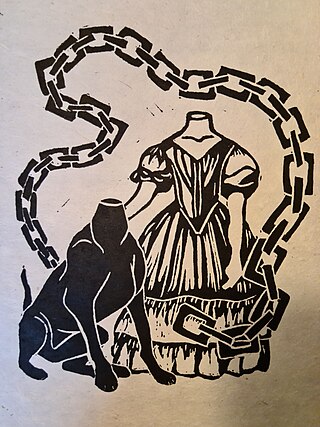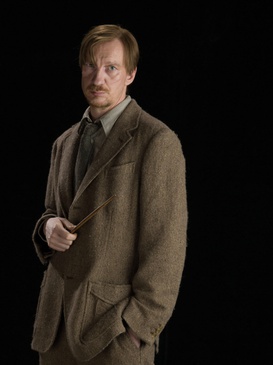Related Research Articles

Lord Voldemort is a character and the main antagonist in J. K. Rowling's series of Harry Potter novels. The character first appeared in Harry Potter and the Philosopher's Stone, which was published in 1997, and returned either in person or in flashbacks in each book and its film adaptation in the series except the third, Harry Potter and the Prisoner of Azkaban, in which he is only mentioned.

A boggart is a supernatural being from English folklore. The dialectologist Elizabeth Wright described the boggart as 'a generic name for an apparition'; folklorist Simon Young defines it as 'any ambivalent or evil solitary supernatural spirit'. Halifax folklorist Kai Roberts states that boggart ‘might have been used to refer to anything from a hilltop hobgoblin to a household faerie, from a headless apparition to a proto-typical poltergeist’. As these wide definitions suggest boggarts are to be found both within and out of doors, as a household spirit or a malevolent genius loci inhabiting fields or other topographical features.The 1867 book Lancashire Folklore by Harland and Wilkinson, makes a distinction between "House boggarts" and other types. Typical descriptions show boggarts to be malevolent. It is said that the boggart crawls into people's beds at night and puts a clammy hand on their faces. Sometimes he strips the bedsheets off them. The household boggart may follow a family wherever they flee. One Lancashire source reports the belief that a boggart should never be named: if the boggart was given a name, it could neither be reasoned with nor persuaded, but would become uncontrollable and destructive.

The Death Eaters are characters featured in the Harry Potter series of novels and films. They are a radical group of wizards and witches, led by the dark wizard Lord Voldemort, who seek to purify the wizarding community by eliminating wizards and witches born to non-magical parents. They attempt to create a new order within the Ministry of Magic by spreading fear through the wizarding community and murdering those who speak out against them. Their primary opposition is the Order of the Phoenix.
Fantastic Beasts and Where to Find Them is a 2001 guide book written by British author J. K. Rowling about the magical creatures in the Harry Potter universe. The original version, illustrated by the author herself, purports to be Harry Potter's copy of the textbook of the same name mentioned in Harry Potter and the Philosopher's Stone, the first novel of the Harry Potter series. It includes several notes inside it supposedly handwritten by Harry, Ron Weasley, and Hermione Granger, detailing their own experiences with some of the beasts described, and including inside jokes relating to the original series.

The Order of the Phoenix is a secret organisation in the Harry Potter series of fiction books written by J. K. Rowling. Founded by Albus Dumbledore to fight Lord Voldemort and his followers, the Death Eaters, the Order lends its name to the fifth book of the series, Harry Potter and the Order of the Phoenix. The original members of the Order of the Phoenix include Sirius Black, Emmeline Vance, Benjy Fenwick, Kingsley Shacklebolt, Edgar Bones, Lily Potter, James Potter, Sturgis Podmore, Caradoc Dearborn, Alice Longbottom, Frank Longbottom, Dorcas Meadowes, Albus Dumbledore, Rubeus Hagrid, Hestia Jones, Remus Lupin, Severus Snape, Aberforth Dumbledore, Dedalus Diggle, Minerva McGonagall and Marlene McKinnon.

Harry Potter and the Goblet of Fire is a fantasy novel written by British author J. K. Rowling and the fourth novel in the Harry Potter series. It follows Harry Potter, a wizard in his fourth year at Hogwarts School of Witchcraft and Wizardry, and the mystery surrounding the entry of Harry's name into the Triwizard Tournament, in which he is forced to compete.

The Ministry of Magic is the government of the Magical community of Britain in J. K. Rowling's Wizarding World, headed by an official entitled the Minister for Magic. The magical government in Britain is first mentioned in Harry Potter and the Philosopher's Stone; the Ministry makes its first proper appearance in Harry Potter and the Order of the Phoenix (2003). Throughout the books, it is regularly depicted as corrupt, elitist and completely incompetent, with its high-ranking officials blind to ominous events and unwilling to take action against threats to wizard society. In Order of the Phoenix, Dolores Umbridge was placed at Hogwarts to observe the happenings within the school, and prevent the spread of news concerning the return of Lord Voldemort. It reaches a zenith of corruption, before being effectively taken over by Voldemort. At the end of the final book, following Voldemort's death, Kingsley Shacklebolt is revealed to have become the Minister for Magic.
In J. K. Rowling's Harry Potter series, magic is depicted as a supernatural force that can be used to override the usual laws of nature. Many fictional magical creatures exist in the series, while ordinary creatures sometimes exhibit magical properties. Magical objects are also described. Witches and wizards refer to the rest of the population, who are generally unaware of magic, as "Muggles" in the United Kingdom and "No-Maj" in the United States.
J. K. Rowling's Harry Potter universe contains numerous settings for the events in her fantasy novels. These locations are categorised as a dwelling, school, shopping district, or government-affiliated locale.
Magical creatures are an aspect of the fictional Wizarding World contained in the Harry Potter series and connected media originally created by British author J. K. Rowling. Throughout the seven main books of the series, Harry and his friends encounter many of these creatures on their adventures in Hogwarts, the Forbidden Forest, or other locations throughout the Wizarding World. In addition, students learn to take care of creatures such as hippogriffs and unicorns in the Care of Magical Creatures class at Hogwarts. Rowling has also written Fantastic Beasts and Where to Find Them, a guide to the magical beasts found in the series, and based on the fictional textbook of the same name written by Newt Scamander and used by students at Hogwarts.
The fictional universe of British author J. K. Rowling's Harry Potter series of fantasy novels comprises two distinct societies: the wizarding world and the Muggle world. In the novels, the Muggle world is the world inhabited by the non-magical majority, with which the wizarding world exists coextensively, albeit mostly remaining hidden from the non-magical humans. The plot of the series is set in 1990s Britain, but in a veiled and separate shadow society wherein magic is commonly used and practised, and those who can use it live in self-enforced seclusion, hiding their abilities from the rest of the world. The term "wizarding world" refers to the global wizard community that lives hidden in parallel with the Muggle world; the different terms refer to different communities within the same area rather than separate planets or worlds. Any new works taking place in this universe are released under the "J. K. Rowling's Wizarding World" brand.
Bloody Bones is a bogeyman figure in English and North American folklore whose first written appearance is approximately 1548. As with all bogeymen the figure has been used to frighten children into proper deportment. The character is sometimes called Rawhead, Tommy Rawhead, or Rawhead-and-Bloody-Bones.

The church grim is a guardian spirit in English and Nordic folklore that oversees the welfare of a particular Christian church, and protects the churchyard from those who would profane and commit sacrilege against it. It often appears as a black dog but is known to take the form of other animals. In modern times, when black dogs are kept as pets in churches and their attached parsonages, these are called church Grims since they reside on and guard ecclesiastical property.
Peg Powler is a hag and water spirit in English folklore who inhabits the River Tees. Similar to the Grindylow, Jenny Greenteeth, and Nelly Longarms, she drags children into the water if they get too close to the edge. She is regarded as a bogeyman figure who is invoked by parents to frighten children into proper behavior. The 19th century folklorist William Henderson describes Peg Powler as having green hair and "an insatiable desire for human life" and she is said to lure people into the river to drown or be devoured. The foam or froth which is often seen floating on certain parts of the Tees is called "Peg Powler's suds" or "Peg Powler's cream".
Jenny Greenteeth a.k.a. Wicked Jenny, Ginny Greenteeth and Grinteeth is a figure in English folklore. A river-hag, similar to Peg Powler and derived from the grindylow, she would pull children or the elderly into the water and drown them. The name is also used to describe pondweed or duckweed, which can form a continuous mat over the surface of a small body of water, making it misleading and potentially treacherous, especially to unwary children. With this meaning the name is common around Liverpool and southwest Lancashire.

The black dog is a supernatural, spectral, or demonic hellhound originating from English folklore that has also been seen throughout Europe and the Americas. It is usually unnaturally large with glowing red or yellow eyes, is often connected with the Devil, and is sometimes an omen of death. It is sometimes associated with electrical storms, and also with crossroads, barrows, places of execution and ancient pathways.

The Magical Worlds of Harry Potter: A Treasury of Myths, Legends, and Fascinating Facts is a guide to the fictional Harry Potter universe, written by David Colbert. It explores the references to history, legends, and literature in J.K. Rowling's Harry Potter novels. Colbert conceived the idea for The Magical Worlds of Harry Potter while quizzing his nephew and nieces about the mythological references in the novels. He later wrote the book while teaching a seminar on self-publishing to graduate students at the University of North Carolina. The book was published in March 2001, without approval from Rowling, and has since received positive reviews from critics. An updated version of The Magical Worlds of Harry Potter was published in 2004 by Berkley Books.
Nelly Longarms is a hag and water spirit in English folklore who dwells at the bottom of deep ponds, rivers and wells. Like the Grindylow, Peg Powler and Jenny Greenteeth she will reach out with her long sinewy arms and drag children beneath the water if they get too close. She is regarded as a bogeyman figure who is invoked by parents to frighten children into appropriate deportment.

Remus John Lupin is a fictional character in the Harry Potter book series written by J. K. Rowling. He first appears in Harry Potter and the Prisoner of Azkaban as the new Defence Against the Dark Arts professor. Lupin remains in the story following his resignation from this post, serving as a friend and ally of the central character, Harry Potter. In the films, he is portrayed by David Thewlis as an adult, and James Utechin as a teenager.
References
- 1 2 The Nineteenth Century and After, Volume 68 (1910). Leonard Scott Pub. Co. p. 556.
- ↑ Schilling, Karl Georg (1906). A Grammar of the Dialect of Oldham. p. 17.
- ↑ "Explanatory Notes on Beowulf".
- 1 2 Harland, John (1867). Lancashire Folk-Lore. Frederick Warne and Co. p. 53.
- ↑ Briggs, Katharine (1976). An Encyclopedia of Fairies. Pantheon Books. p. 206. ISBN 0394409183.
- ↑ Wright, Elizabeth Mary (1913). Rustic Speech and Folk-Lore. Humphrey Milford, Oxford University Press. pp. 198-199.
- ↑ Colbert, David (2008) [2001]. The Magical Worlds of Harry Potter. Berkley Publishing Group. pp. 123-124. ISBN 0-9708442-0-4
- ↑ Briggs (1976). pp. 242, 323.
- ↑ Wright (1913). pp. 198–199, 202.
- ↑ Rowling, J. K. (1999). Harry Potter and the Prisoner of Azkaban. Scholastic Press. p. 154. ISBN 0-439-13635-0.
- ↑ Pathfinder Roleplaying Game: Bestiary 2. Paizo Publishing they resemble their appearance in the Harry Potter films, though tend to be depicted as blue. December 2010. ISBN 978-1-60125-268-5.